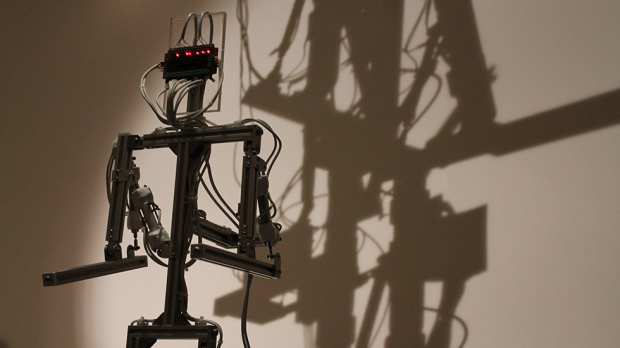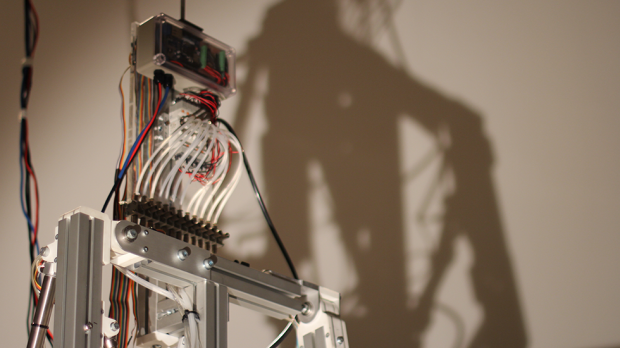
How far would you go to explore an idea? Would you use your stomach as an art gallery? Would you grow a third ear on your arm, and stream what it was hearing? For decades Stelarc’s art has challenged and explored the human body’s relationship with technology. As part of PICA’s HyperPrometheus: The Legacy of Frankenstein his latest work, Stickman/ miniStickman (this Saturday, October 20 from 12pm-5pm), will see the artist subjected to “virtual voodoo” for five hours, as he is strapped to an exo-skeleton and manipulated by a computer algorithm. DAVID O’CONNELL spoke to Stelarc about his art, technology, and the work of Mary Shelley.
What is Stickman/ miniStickman?
Stickman is a minimal, but full body, exo-skeleton which algorithmically actuates the body. It’ll be a five hour performance, and don’t know what gestures the system is going to choose, but that happens continuously. But there’s a miniStickman, that does a kind of virtual voodoo, where someone can interact and insert their choreography into my movements. By bending the interface and pressing play, their movements will be looped. So I may be repeating their movements four times, I may be repeating their movement 15 times… (laughs)

As HyperPrometheus is a commemoration of the 200th anniversary of Mary Shelly’s work, how does your work relate to Frankenstein?
I don’t think the exhibition illustrates Frankenstein literally, however, it’s in terms of issues of genetic modification, mechanical monstrosities, prosthetic bodies. My talk for example is more about how the monstrous is no longer the stitched up meat body, but rather the virtual systems that suck the self into an online and distributed system of operation. In other words we can consider virtuality as a monstrous invasion of the biological body. For me the body is a chimera of meat, metal, and code – we’re still biological body, but we are augmented by tech, extended by our instruments, and our micro biome is contaminated by code.
We still have this romantic nostalgia for the biological body, but most of us have wireless mediums that allow us to project virtually and remotely.

Your work overall tends to have a more neutral view of technological advancement than Shelley did in hers. Is that fair to say?
It is not a dystopian view. What that Frankensteinian fear has generated is a distrust of modifying the body, doing anything beyond the natural, of creating life. All these sorts of concerns now are given a kind of a dystopian colour. On the other hand what is interesting for me, is not control but complexity of operation. The human body, aided by technology, can move at 100km per hour on the surface, 500km per hour in the air, or faster. Without instruments we could not observe or conceive the complexity of microbial life, or generated the cosmological theories we have, without a radio-telescope. So I take neither a dystopian or utopian view.
As Paul Virilio said, with each new technology there is a new kind of accident. It isn’t always enabling, it isn’t always progressive, we have to manage the ethical implications.
We have to reconsider what it means to be a body, what it means to be human. Now you are not likely to die a biological death, but rather when your life support system is switched off.

How would you describe your role as an artist in that communication?
Artists are not journalists. What you are doing is very different to what an artist is doing. Art doesn’t directly represent or illustrate an idea. Art should generate ideas. It’s more about generating ambivalence, anxiety, unexpected aesthetic arrangements, maybe conjuring up unexpected ethical issues. For example when I first saw 2001, I was not sure what was going on with the ending, I ended up seeing it 15 times. Not just because of the storyline, or the non-narrative, but because of the conceptual interest of it, the expansiveness of its content, and the interesting questions it was asking. If you walk out of a movie and are satisfied by it, it probably wasn’t an interesting movie. Same with art. There’s got to be some ambivalence about what you’re experiencing. Art is more about affect than information.

One of the inspirations for Frankenstein was galvanism (stimulation of muscles through electricity), which you’ve actually used that in some of your pieces. What is it like to experience it first hand?
I did a series of performances using muscle stimulation systems, connecting to computers online (Fractal Flesh, Ping Body, Parasite). It is very strange when your body moves, and you yourself haven’t initiated that movement, or even contracting your own muscles. It is different to Stickman which is a pneumatically activated prosthesis, but for those performances my neural system was plugged into the online interactive muscle simulation.

How did you become inspired to take this approach to your art originally?
I discovered I was a bad painter in art school (laughs).
I was always interested in the human body and the evolutionary architecture of the body, so the idea of performing with your own body was particularly seductive. You’d watch gymnasts and dancers, and their performance was not only an artistic expression, but a bodily experience. These performances are just that, you have to take the physical consequences of your ideas – you are not dealing just with symbols or metaphors.